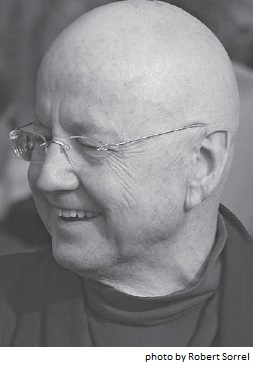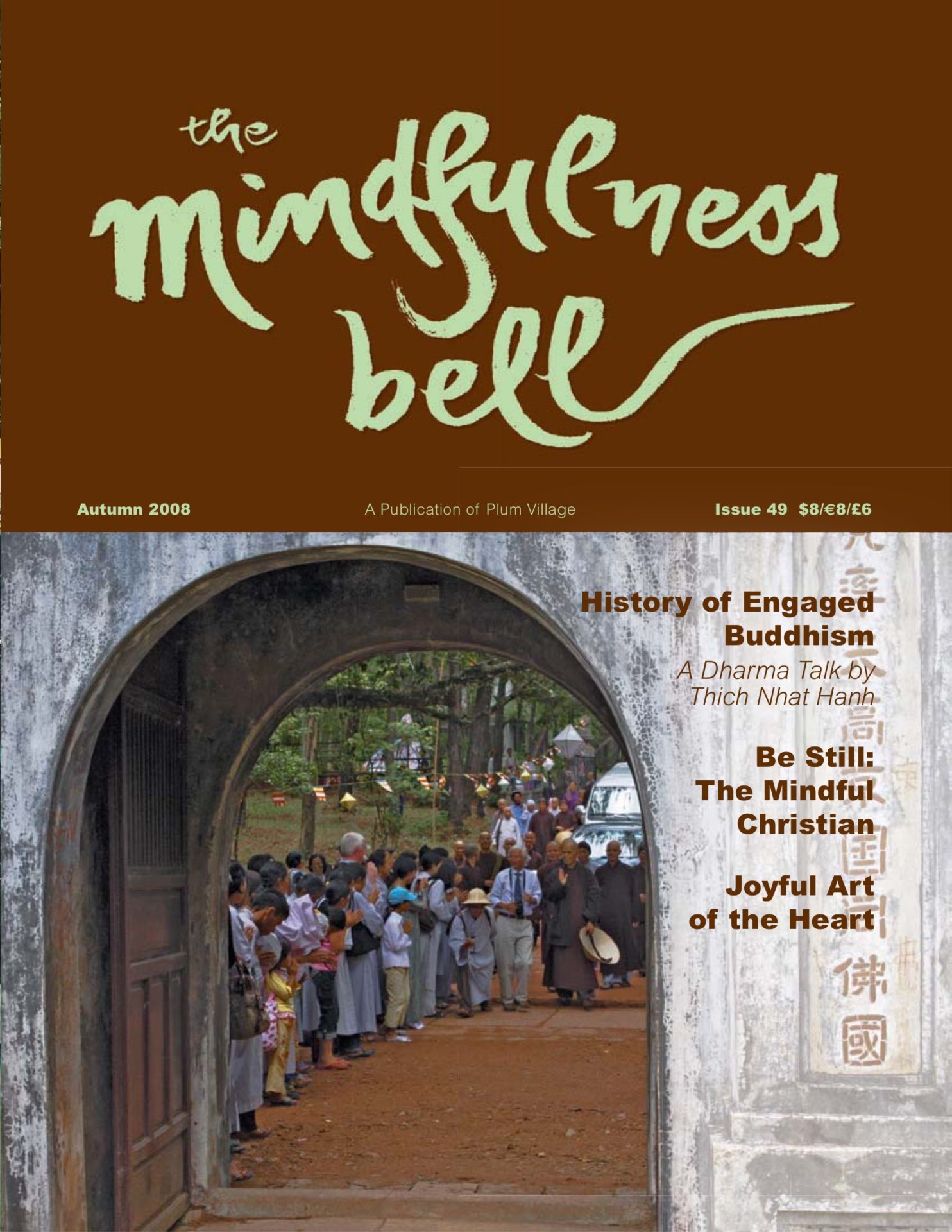December 8, 2007 — Feast of the Immaculate Conception
By Brother Phap De

This morning, I awaken and smile, saying “Twenty-four brand new hours are before me! I vow to live each moment fully, mindfully, and to look at all beings with eyes of compassion.”
Then, I light a candle and a stick of incense before a picture of Mom, Dad, and my brothers and sisters,
December 8, 2007 — Feast of the Immaculate Conception
By Brother Phap De

This morning, I awaken and smile, saying “Twenty-four brand new hours are before me! I vow to live each moment fully, mindfully, and to look at all beings with eyes of compassion.”
Then, I light a candle and a stick of incense before a picture of Mom, Dad, and my brothers and sisters, saying, “In gratitude, I offer this incense to you and all my ancestors. May it be fragrant as flowers, reflecting my loving reverence and gratitude. May we all be companions of the saints, especially Mary, our Mother of Compassion, on this Feast of the Immaculate Conception.”

Thanks to Thay and to the Vietnamese practice of ancestor worship, this Catholic now feels connected to his ancestors and is nourished by reverential gratitude to his parents and other ancestors—a practice that the misguided Catholic bishops and priests tried to stop in Vietnam. When I light a candle and make the incense offering in front of their picture, I know that they are not actually in the picture. Rather, I know that they are actually in me. I know that the real altar of my ancestors is my body/mind on which I honor them by the way I live, particularly as expressed in the Fifth Mindfulness Training, mindful consumption. This living connection to my ancestors is helping me let go of my attachment to my ego, my notion of being a separate self and somebody special.
Only Zen Monks Stop
At 4:45 a.m., I quietly brew a cup of tea, without waking up my roommate. Drinking my tea, I gratefully remember that it was Mom who first taught me the devotion to Mary. As a boy, I prayed to Mary for many different things—even for assistance in winning basketball games.
After this, our ordinary day begins with sitting meditation (Holy Hour) at 5:30 a.m.
At 7:00 a.m., the centuries-old church bells sound the Angelus, calling us to stop and remember that Mary said “Let it be” to the Angel, and became the mother of Jesus. In the old days, everyone stopped at the sound of the bells and recited three Ave Marias. Nowadays, only the Zen monks stop. I love the sound and recite an Ave. Hearing the Angelus bells is like hearing the voice of Christ, calling me back to my true self and inviting me to be like Mary: with the energy of the Holy Spirit, to give birth to Christ in my own life, in my own soul and body. I know that if I don’t, then what she did will have been wasted as far as my life is concerned.
As the Angelus bells continue, I remember the Gospel story of how the newly pregnant Mary “set out and walked with haste” (she had not yet learned slow walking meditation) to the home of her cousin, Elizabeth, who greeted her with: “Blessed are you among women.” (Luke 1:39 and 42) The sound of the Angelus bells wakes me up to the realization that like Mary, my brothers and sisters embody Christ-consciousness here and now. Thus, like Elizabeth, I say to my sisters and brothers: “Blessed are you.” How lucky we are!

Then, breakfast at 7:30. We sit, in a circle, on cushions on the floor—twenty monks and six laypersons, breaking bread together. I am surrounded by my companions. I remember that the word “companion” comes from com (together) and pan (bread), that is, breaking bread together. I remember Jesus breaking bread with his disciples. This morning I see the abbot’s mother sitting and eating with us—like Mary did with Jesus and his companions. I look gratefully at the two cooks, a New Zealander and a Vietnamese, who prepared the food, even though they understand very little of each other’s language. This is the Holy Thursday brotherhood meal and Pentecost (enlightenment) in the here and now.
Walking with Mother Mary
We study from 9:15 a.m. until we gather for walking meditation at 11:00. I usually invite Dad and Mom to walk with me. How can they not, for they are in me. Dad is learning how to walk more slowly, keeping his attention on the flowers and surroundings, not on the destination or job waiting ahead.
Today, I also invite Mother Mary to walk with me. After all, she is my spiritual ancestor and I am blessed with her spiritual DNA—the Christ-consciousness in me. Today, holding my hand, Mother Mary no longer walks “with haste.”
The divine feminine energy of Mary is very much with me in this Zen Buddhist monastery. (Buddhists know Mother Mary as Avalokita or Quan The Am or Kwan Yin.) Many of us can experience Mary’s spiritual DNA through our practice of touching the earth, when we lie on Mother Earth and reflect on the presence of her healing energy in each of us and in the body of our community. We chant Namo Bo Tat Quan The Am and send her healing energy to people around the world. This chant often brings tears of joy and gratitude to the listeners. To me, it feels like it generates the same energy that’s found in Lourdes and Fatima, energy that once seemed lost to me.
Now, it is 4:00 p.m. and time to do my working meditation: clean the meditation hall before the community arrives for the evening sitting meditation and chanting. When I was a priest forty years ago, lay persons cleaned the church after I celebrated Mass. Now, it’s my turn. I am learning humility—like Mary. They used to call me Father Adrian, now I am called Phap De, Young Brother. Five years ago, Thay told me that to become a monk I would have to give up my stock portfolio, property, bank accounts, and cars, and he said, “You will learn humility.” It has been surprisingly easy. Phap De is living joyfully and peacefully.
Her Wondrous Light
6:00 p.m.—Tonight, on this Feast of the Immaculate Conception, I was delighted when my Vietnamese brother led us in a chant of praise to the Great Saint of Compassion, Mary. Here are the lyrics:
From the depths of understanding, the flower of great eloquence blooms: The bodhisattva stands majestically upon the waves of birth and death, free from all afflictions. Her great compassion eliminates all sickness, even that once thought of as incurable. Her wondrous light sweeps away all obstacles and dangers. Her willow branch, once waved, reveals countless heavens, Her lotus flower blossoms a multitude of practice centers. We bow to her. We see her true presence in the here and now. We offer her the incense of our heart. May the Bodhisattva of Deep Listening embrace us all with great compassion. Praise to thee, Mary, Our Mother of Compassion.
9:00 p.m.—I am aware that I have come a long way and have let go of some old theological notions about Original Sin and the Fall/Redemption paradigm. “We have entered a broken and torn and sinful world — that’s for sure,” writes theologian Matthew Fox. “But we do not enter as blotches on existence, as sinful creatures. We burst into the world as original blessings.” Now I can see the dogma of the Immaculate Conception (Mary was conceived without original sin) as an effort to help us wake up to the magnificence of Mary.
The Buddha’s gift of the communal practice of the mindfulness trainings helps this Catholic to live up to the example of Mary and the teachings of Jesus. We may be ordinary persons, but, like Mary, we are all Immaculate Conceptions. The joyful Angelus Bells repeatedly invite us to wake up to this Good News!
Brother Phap De (Brother Adrian) lives in Son Ha at Plum Village. Once upon a time, he worked as a Roman Catholic parish priest and teacher.

